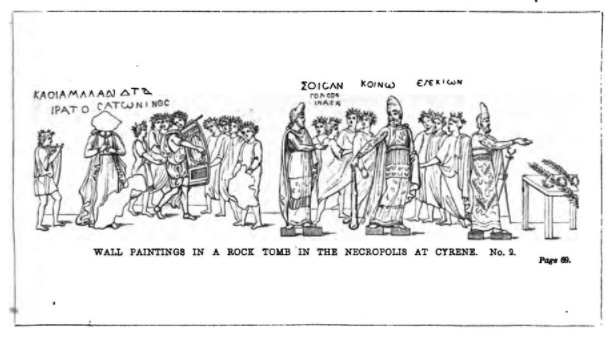Necropolis of Cyrene on:
[Wikipedia]
[Google]
[Amazon]
The Necropolis of Cyrene is a
 Earliest traces of Cyrene date back to about 700 BC, it is considered to be the oldest and largest
Earliest traces of Cyrene date back to about 700 BC, it is considered to be the oldest and largest  James Hamilton described the Necropolis of Cyrene in his visit 1856:
James Hamilton described the Necropolis of Cyrene in his visit 1856:
File:Necropolis-of-Cyrene-tomb-entrance-Smith-Porcher-1861-Wadi-Haleg-Shaloof.jpg, Smith and Porcher 1861
File:Necropolis-of-Cyrene-tomb-entrance-Wadi-Bel-Ghadir-Weld-Blundell-1894.jpg, Weld-Blundell 1894
File:Necropolis-of-Cyrene-tomb-entrance-Weld-Blundell-1894.jpg, Weld-Blundell 1894
File:Necropolis-of-Cyrene-tomb-entrance-Weld-Blundell-El-Mawy-Land-1894.jpg, Weld-Blundell 1894
File:Necropolis-of-Cyrene--tomb-Interior-1861.jpg, Porcher 1861
File:Necropolis-of-Cyrene---tomb-statues-1.jpg, Beechey 1850,
necropolis
A necropolis (plural necropolises, necropoles, necropoleis, necropoli) is a large, designed cemetery with elaborate tomb monuments. The name stems from the Ancient Greek ''nekropolis'', literally meaning "city of the dead".
The term usually im ...
located between Cyrene, Libya
Cyrene ( ) or Kyrene ( ; grc, Κυρήνη, Kyrḗnē, arb, شحات, Shaḥāt), was an ancient Greek and later Roman city near present-day Shahhat, Libya. It was the oldest and most important of the five Greek cities, known as the pentapolei ...
and the ancient port of Apollonia, at the western slope of the Wadi Haleg Shaloof hill. It is around 10 square kilometres in size. With terraced archaic tombs, the cemetery is near the ancient road to Apollonia. The necropolis is today partially lost, parts were bulldozed in 2013. The UNESCO
The United Nations Educational, Scientific and Cultural Organization is a specialized agency of the United Nations (UN) aimed at promoting world peace and security through international cooperation in education, arts, sciences and culture. It ...
classified the site in 1982 as a World Heritage Site
A World Heritage Site is a landmark or area with legal protection by an international convention administered by the United Nations Educational, Scientific and Cultural Organization (UNESCO). World Heritage Sites are designated by UNESCO for h ...
, and added Cyrene in 2017 to its List of World Heritage in Danger
The List of World Heritage in Danger is compiled by the United Nations Educational, Scientific and Cultural Organization (UNESCO) through the World Heritage Committee according to Article 11.4 of the World Heritage Convention,Full title: ''Conv ...
.
General
 Earliest traces of Cyrene date back to about 700 BC, it is considered to be the oldest and largest
Earliest traces of Cyrene date back to about 700 BC, it is considered to be the oldest and largest Greek
Greek may refer to:
Greece
Anything of, from, or related to Greece, a country in Southern Europe:
*Greeks, an ethnic group.
*Greek language, a branch of the Indo-European language family.
**Proto-Greek language, the assumed last common ancestor ...
colony
In modern parlance, a colony is a territory subject to a form of foreign rule. Though dominated by the foreign colonizers, colonies remain separate from the administration of the original country of the colonizers, the ''metropole, metropolit ...
in eastern Libya
Libya (; ar, ليبيا, Lībiyā), officially the State of Libya ( ar, دولة ليبيا, Dawlat Lībiyā), is a country in the Maghreb region in North Africa. It is bordered by the Mediterranean Sea to the north, Egypt to Egypt–Libya bo ...
. It is believed that the ancient, now extinct plant Silphium
Silphium (also known as ''silphion'', ''laserwort'', or ''laser'') is an unidentified plant that was used in classical antiquity as a seasoning, perfume, aphrodisiac, and medicine. It also was used as a contraceptive by ancient Greeks and Romans ...
only grew in the Cyrene region.
In 2013 the local archaeology professor Ahmed Hussein from Bayda University noted:
 James Hamilton described the Necropolis of Cyrene in his visit 1856:
James Hamilton described the Necropolis of Cyrene in his visit 1856:
Excavations
Excavations began in the 19th century, or earlier. Richard Norton excavated the site in 1911.Rowe
Rowe may refer to:
Places
* Rowe, Massachusetts, U.S.
*Rowe, New Mexico, U.S.
*Rowes Bay, Queensland, a suburb of Townsville Australia
*Rowe, now Rówek, Poland
Other
*Rowe (surname)
*Rowe (musician), solo project of Becky Louise Filip, former me ...
, found fragments of a Ptolemaic Ptolemaic is the adjective formed from the name Ptolemy, and may refer to:
Pertaining to the Ptolemaic dynasty
* Ptolemaic dynasty, the Macedonian Greek dynasty that ruled Egypt founded in 305 BC by Ptolemy I Soter
* Ptolemaic Kingdom
Pertaining ...
cinerary urn, a Theia
In Greek mythology, Theia (; grc, Θεία, Theía, divine, also rendered Thea or Thia), also called Euryphaessa ( grc, Εὐρυφάεσσα) "wide-shining", is one of the twelve Titans, the children of the earth goddess Gaia and the sky god ...
figure, and surveyed, excavated tombs there between 1952 and 1957. Rowe was the first to make an extensive archaeological study of the Necropolis of Cyrene, however, many artifacts from his excavations, and from Oliverio in 1925, are today considered to be lost. Burton Brown excavated two sarcophagi and a Roman
Roman or Romans most often refers to:
*Rome, the capital city of Italy
*Ancient Rome, Roman civilization from 8th century BC to 5th century AD
*Roman people, the people of ancient Rome
*''Epistle to the Romans'', shortened to ''Romans'', a letter ...
burial in 1947. Beschi excavated two tombs in 1963.
Gallery
funerary
A funeral is a ceremony connected with the Disposal of human corpses, final disposition of a corpse, such as a burial or cremation, with the attendant observances. Funerary customs comprise the complex of beliefs and practices used by a culture ...
statues
File:History of Egypt, Chaldea, Syria, Babylonia and Assyria (1903) (14783480743).jpg, Illustrated in the book "''History of Egypt, Chaldea, Syria, Babylonia and Assyria (1903)''"
See also
*Ancient Libya
The Latin name ''Libya'' (from Greek Λιβύη: ''Libyē'', which came from Berber: ''Libu'') referred to North Africa during the Iron Age and Classical Antiquity. Berbers occupied the area for thousands of years before the recording of histor ...
References
{{Reflist, 2 Cemeteries in Libya World Heritage Sites in Libya Archaeological sites in Libya Greek colonies in Libya Temples of Apollo Ancient Cyrenaica Ancient Greek archaeological sites in Libya Necropoleis